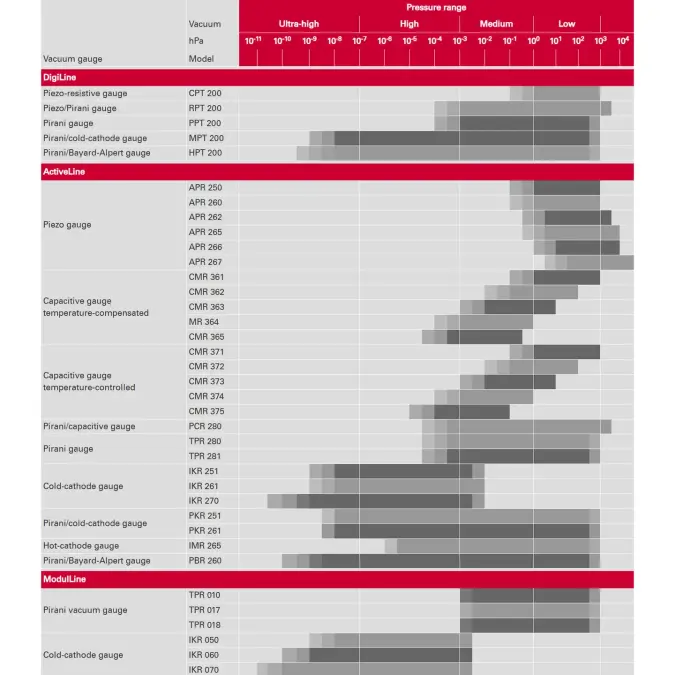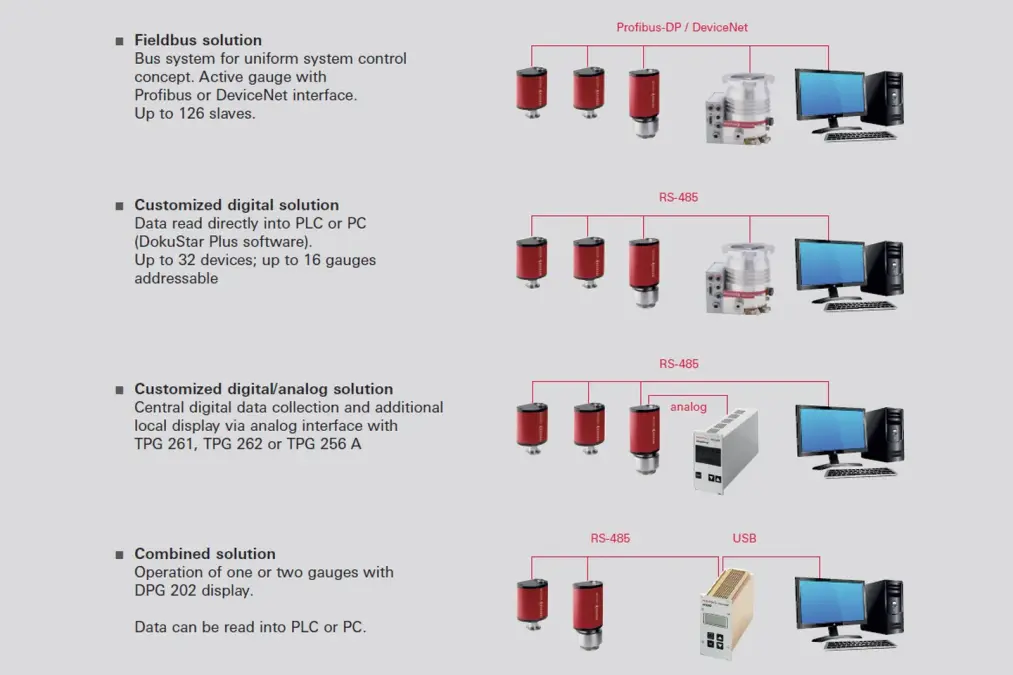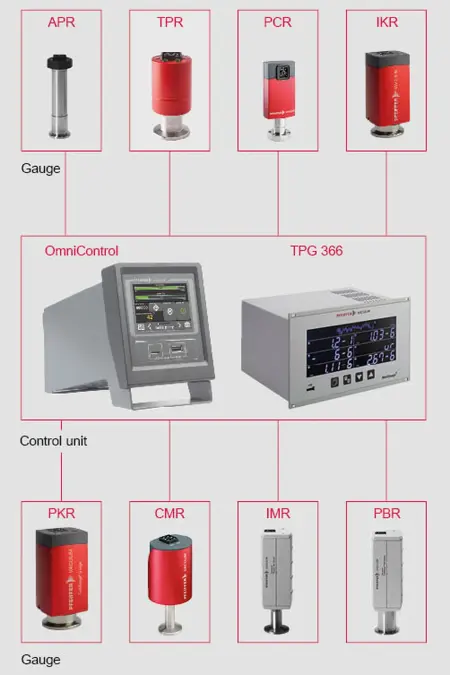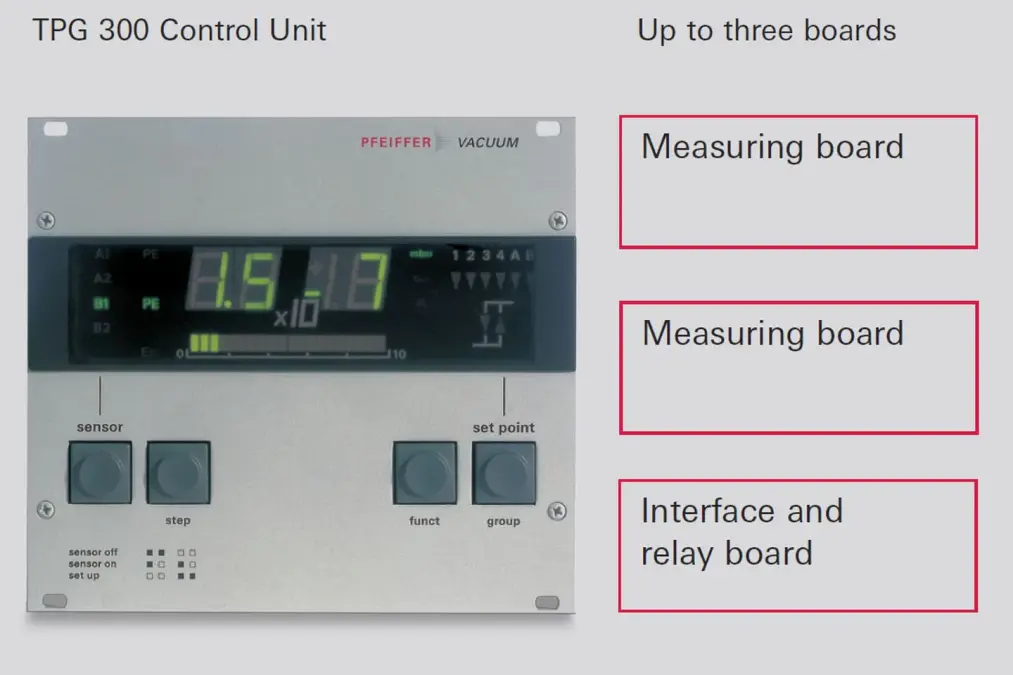Vacuum gauge selection guide
Readings at the limits of the range may be less accurate depending on the measuring principle.-

Table 5.2: Vacuum gauge selection guide
5.3.1 DigiLine
The active gauges in the DigiLine range provide their pressure signals via a serial RS-485 or fieldbus interface. They are supplied with 24 VDC. The various application options are described in Figure 5.9.Up to two gauges can be operated and their pressure values displayed with the DPG 202 power supply unit. The DPG 202 has a USB interface for connecting a PC. Signals from the active DigiLine vacuum gauges can also be directly processed by a PLC or PC and displayed by the DokuStar Plus software.
-

Figure 5.9: Application concepts DigiLine
Optional versions of DigiLine gauges are available with interfaces for Profibus-DP and DeviceNet fieldbus standards. This enables these vacuum gauges to be easily integrated into the fieldbus networks of plant control systems with all the known advantages of savings through less wiring and cabling and fast initial start-up.
A further option is DigiLine gauges with an additional analog output and switch-points. The analog output can be used for tasks such as setting up a local pressure isplay for a transmitter that is linked to a central control system. The switch-points allow hard-wired safety functions to be provided independently of the controlling computer.
Active DigiLine vacuum gauge offer the following advantages:
Active DigiLine single-sensor gauges are available in the form of a piezo-diaphragm system CPT 200 (2,000 – 1 hPa) and a Pirani system PPT 200 (1,000-10-4 hPa).
The following gauges with combination sensors are available in the DigiLine series:
A further option is DigiLine gauges with an additional analog output and switch-points. The analog output can be used for tasks such as setting up a local pressure isplay for a transmitter that is linked to a central control system. The switch-points allow hard-wired safety functions to be provided independently of the controlling computer.
Active DigiLine vacuum gauge offer the following advantages:
- The pressure range from 5 · 10-10 to 2,000 hPa covers the entire vacuum range
- Freely combinable components
- Secure data transmission thanks to digital signals
- Pressure values are transmitted numerically so no curve correction or conversion is required
- Profibus-DP and DeviceNet fieldbus interfaces
- Data can be analyzed directly on a PC with DokuStar Plus software
- Remote control for easy adjustment
- Protection class IP54 and DIN M12 connector assemblies for reliable operation in harsh environments
Active DigiLine single-sensor gauges are available in the form of a piezo-diaphragm system CPT 200 (2,000 – 1 hPa) and a Pirani system PPT 200 (1,000-10-4 hPa).
The following gauges with combination sensors are available in the DigiLine series:
- Piezo-Pirani combination RPT 200. Since the thermal conductivity effect for the Pirani vacuum gauge for pressures p > hPa is not a function of pressure, a diaphragm vacuum gauge is used for pressures p > 10 hPa. This affords good accuracy throughout the entire measurement range from 1,200 to 1 · 10-4 hPa, enabling processes such as chamber venting to be precisely controlled by this gauge.
- Pirani-cold cathode combination MPT 200. This combination covers the pressure range from 1,000 to 5 · 10-9 hPa. The gas discharge of the cold cathode measuring sensor is initiated by the pressure that is measured with the Pirani sensor. Using this process prevents inadvertent activation of the cold cathode at excessive pressure, thus avoiding contami- nation.
- Pirani/Bayard-Alpert combination HPT 200. This covers a pressure range from 1,000 to 5 · 10-10 hPa. Pressure monitoring by the Pirani sensor protects the hot cathode gauges from operating at excessively high temperatures and prevents burn-out of the hot cathode. This enables extremely long cathode service life to be achieved.
5.3.2 ActiveLine
The ActiveLine family includes three control units and eight active vacuum gauges with 0 – 10 volt analog outputs. All transmitters are equipped with identical connector assemblies and can therefore be operated with the same measurement cable on the control units. Measurement cables are available in standard lengths of 1 to 50 meters.The active piezo vacuum gauges APR cover five measurement ranges from 5.5 MPa (55 bar) to 10 Pa (0.1 mbar) with six models.
Capacitive diaphragm vacuum gauges CMR are available in the form of both temperature-compensated and temperature-regulated versions, in five measurement ranges each from 1100 hPa – 10-5 hPa. The use of diaphragms with different rated values (full scale = F.S.) results in the following categories:
- 1,000 hPa F.S. Pressure range 1,100 to 10-1 hPa
- 100 hPa F.S. Pressure range 110 to 10-2 hPa
- 10 hPa F.S. Pressure range 11 to 10-3 hPa
- 1 hPa F.S. Pressure range 1.1 to 10-4 hPa
- 0.1 hPa F.S. Pressure range 0.11 to 10-5 hPa
These ceramic-technology gauges from Pfeiffer Vacuum have a proven track record in many, especially corrosive applications.
For use in microtechnology with its commonly used units of Torr and mTorr, capacitive diaphragm vacuum gauges CCR can be supplied with rated values in Torr:
- 1,000 Torr F.S. Pressure range 1,332 to 10-1 hPa
- 100 Torr F.S. Pressure range 133 to 10-2 hPa
- 10 Torr F.S. Pressure range 13.3 to 10-3 hPa
- 1 Torr F.S. Pressure range 1.33 to 10-4 hPa
- 0.1 Torr F.S. Pressure range 0.13 to 10-5 hPa
The CCR series has D-Sub connector assemblies and its power supply and output voltages are compatible with other commercial capacitive transmitters. Due to these features, however, they cannot be operated with ActiveLine control units.
The range of single-sensor ActiveLine transmitters is rounded off with two active Pirani vacuum gauges TPR for the medium vacuum range of 1,000 hPa to 5 · 10-5 hPa and three active cold cathode vacuum gauges IKR with measuring ranges of 10-2 to 5 · 10-11 hPa.
The TPR Pirani gauges can also be connected to DCU pumping station display control units, thus providing a pressure reading at no additional expense.
The electrodes (anode, cathode, collector) in the sensor of the active hot cathode vacuum gauge IMR 265 are designed with extremely small clearances between each other. Molecular flow therefore prevails, even at pressures p < 10-2 hPa, enabling ion currents there to be measured. An additional advantage of this transmitter is its lower sensitivity to contamination than the Bayard-Alpert design which makes it very suitable for controlling vacuum processes that are primarily in the lower medium vacuum range.
The following active vacuum gauges with combination sensors are available:
- Capacitive diaphragm-Pirani combination gauge PCR 280 for a pressure range of 1,500 to 5 · 10-4 hPa; a combination of the efficient Pirani sensor with a diaphragm sensor which is accurate in the gross vacuum range
- Pirani cold-cathode combination gauges PKR 251 and 261 for the pressure range of 1,000 to 5 · 10-9 hPa; the ideal combination of robust sensors for a wide range of vacuum applications
- Pirani/Bayard-Alpert combination gauge PBR 260 for a pressure range of 1,000 to 5 · 10-10 hPa; ideal pressure measurement in the high and ultra-high vacuum range combined with the safety of the hot cathode filament provided by the Pirani sensor
ActiveLine gauges offer the following advantages:
- Coverage of the entire vacuum range
- Three control units TPG 261, TPG 262 and TPG 256 A for one, two or six measuring instruments for all requirement profiles
- Control units with automatic gauge recognition prevent installation faults
- Each vacuum gauge can be operated with any control unit
- Easy cabling through use of identical standard cable for all gauges
-

Figure 5.10: ActiveLine application concepts
5.3.3 ModulLine
The ModulLine series includes three passive Pirani vacuum sensors TPR for the pressure range of 1,000 to 8 · 10-4 hPa and three cold cathode vacuum sensors IKR for the pressure range of 5 · 10-3 to 10-11 hPa. Because these vacuum sensors do not contain any electronics, they are suitable for use in high-radiation environments. A large range of cables is available to enable the control unit to be installed at a great distance from place of use of the vacuum sensors.A TPG 300 with the following features serves as the control unit:
- Modular design for a variety of measuring boards
- Two measuring boards can be inserted, as well as an RS-232/RS-485 interface board with relay outputs
- Connection of up to four vacuum sensors
- Fieldbus connection is possible
-

Figure 5.11: TPG 300 control unit for ModulLine sensors